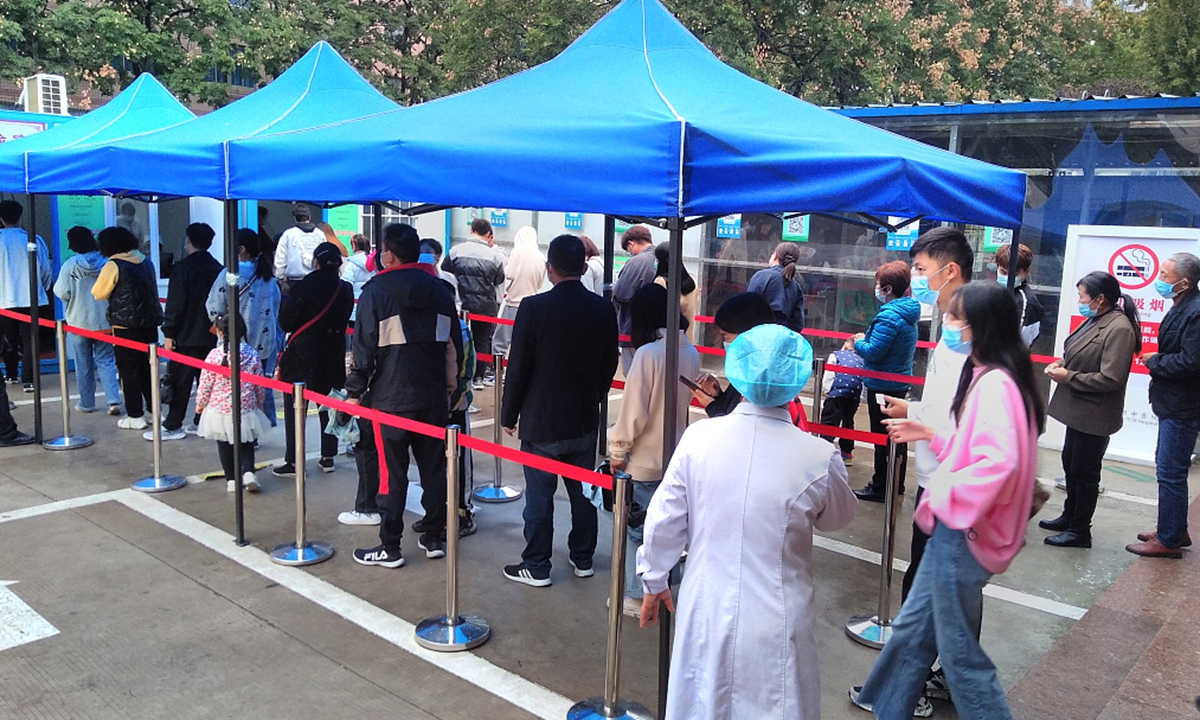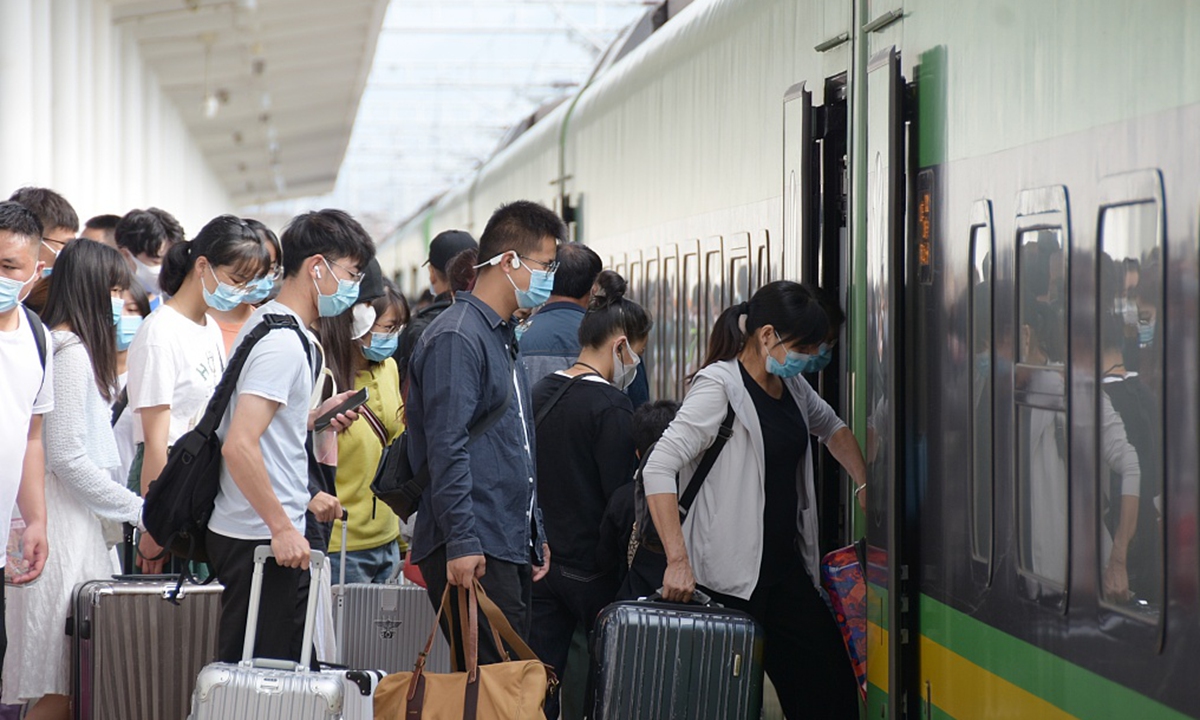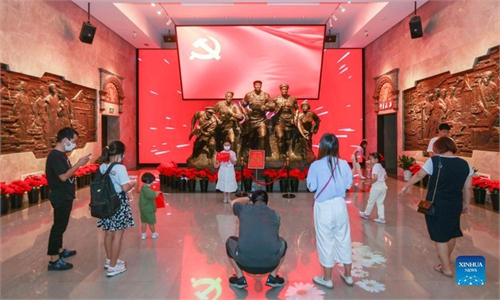China’s insistence on zero-tolerance epidemic strategy highlights post-holiday boom in COVID-19 testing demand
China’s insistence on zero-tolerance epidemic strategy behind demand

Photo:VCG
As the seven-day National Day holidays end, booming nucleic acid testing across China has followed, with multiple regions in the country suggesting that holiday goers receive testing before returning to work or school.
Experts view the post-holiday demand as China's insistence on a preventive and zero-tolerance epidemic strategy, which has been proven right in past rounds of epidemic flare-ups and holidays.
The Global Times visited venues in Beijing and Shanghai on Friday where dozens of people waited in line to receive a test. People could receive a nucleic acid test by simply scanning a QR code and paying the fee of 60 yuan to 80 yuan ($9.30-$12.40).
Making a huge comparison to testing in early stage of the epidemic, people have to scramble for a test. An on-site medical staff in Beijing said more people are coming to receive tests in the later days of the holiday but the waiting time is short--15 minutes at most, and the testing is done in seconds.
Xi'an, a city in Northwest China's Shaanxi Province, requires any passenger who traveled to or from the city to have a negative test report within 48 hours. Guangzhou, which will host the Canton Fair next week, beefed up anti-epidemic policy by requiring people who enter or go out of the city to submit a negative test report starting Friday.
Apart from these two cities, the Global Times found receiving a nucleic acid test is not mandatory in most regions as notices released by local disease control and prevention departments showed.
To facilitate and encourage residents to receive tests, South China's Shenzhen provided free nucleic acid tests in 85 testing venues on the day of Thursday to people who returned the city; some testing centers in Shanghai offer 24-hour non-stop service; Dongguan, another southern city, has added testing collection points and medical staff.
A senior official at the Chinese Center for Disease Control and Prevention told the Global Times on Friday on condition of anonymity that nucleic acid testing is the best way to rule out potential COVID-19 infections. Behind rising testing demand is China's insistency on a zero-tolerance epidemic strategy.
Aside from the Spring Festival in 2020 when people were forced to separate from their families or were stuck at home for weeks due to sweeping epidemic, China has withstood tests of massive flow of people in succeeding holidays safely, including the May Day and National Day holidays.

Photo:VCG
China witnessed 515 million domestic passenger trips in the past National Day holidays amid epidemic resurgences in East China's Fujian and Northeast China's Harbin, that's 70.1 percent of trips made during the same period before the COVID-19 epidemic, official data showed.
"In the early stage of the epidemic in Wuhan, we could not identify potential COVID-19 patients, or dared to believe we would be able to fundamentally cut off the virus spread. We thought a pandemic across the country would be inevitable. But now Wuhan is capable of testing 10 million people in three days and China successfully blocks the virus from entering the gateway using the zero-tolerance anti-epidemic strategy," the official noted.
The official added that either the production, supply of nucleic acid testing kits of production companies or testing capabilities of medical institutes or third-party testing institutes have rocketed. The strong testing capability not only guarantees the routine nucleic acid testing on key groups who are of high risk in contracting the virus across the country, but also ensures the successful implementation of the zero-tolerance anti-epidemic strategy in an epidemic outbreak.
Several testing kit producing companies reached by the Global Times said the current nucleic acid test kits in the domestic market are adequate amid soaring orders around the National Day holidays.
Latest statistics of the National Medical Products Administration showed 56 novel coronavirus detection reagents have been approved nationwide, including 26 nucleic acid detection reagents.
Deng Zhongping, deputy general manager of testing kit manufacturing company Sansure Biotech in Changsha, Central China's Hunan Province, told the Global Times on Friday that since the beginning of the year, the company has been working overtime to ensure supply and sufficient product inventory. Supply could be adjusted anytime based on market demand.
In the first half of the year, Sansure Biotech's COVID-19 business was progressing steadily, with the company's nucleic acid detection reagents being shipped nearly 90 million copies, a year-on-year increase of 142.64 percent. The average daily production capacity of the company reached 5 million units in August, which is enough to cover both domestic and overseas demand for testing kits, Deng said.
According to the new guideline released by the National Health Commission, a Chinese city with a population of up to 5 million should finish mass nucleic acid tests in two days and a city where the population exceeds 5 million finish tests within three days.
The new guideline also requires each province to set up at least 10 nucleic acid testing support teams, and each nucleic acid testing team shall reserve relevant materials that could supply daily testing capacity of 10,000 tubes to undertake mass tests of their region and other regions in need.
The senior official with China's CDC said testing capability of each city is diverse, therefore the testing aid will be deployed to epidemic-stricken region in an emergency, which has also become an essential part of the country's zero-tolerance epidemic policy.
In response to Western suspicions of China's anti-epidemic path, observers said rounds of epidemic resurgence proves the right path of the country's anti-epidemic strategy, but lax of the policy will depend on the epidemic situation.
Such a path will continue and the specific policies may change when the effective vaccination rate is high enough, China's top respiratory expert Zhong Nanshan said recently. Zhong believes the criterion for China to generally relax border control is 80 to 85 percent overall population vaccinated.
The total administered COVID-19 vaccine doses have surpassed 2.21 billion as of Thursday, data from the NHC showed.
China's vaccination rate will reach 80 percent by year's end, and the question to be addressed is how to maintain an effective protection rate which naturally declines after half a year. "That is what we are doing now - to develop more vaccines and to research on how to boost immunity," Zhong said.


